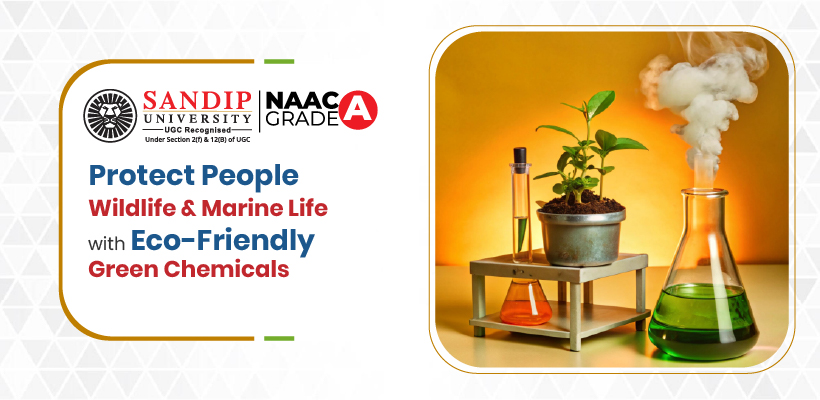Chemistry is one of the most fascinating subjects. It provides us with facts and explanations to some of the happenings that need immediate attention to resolve. Similarly, today, pollution is a serious concern that the world is dealing with, and it requires sustainable solutions. Therefore, every educational institution must educate the next generation about the crisis and its effective solutions.
This blog will discuss the rise of green chemistry and the role of Sandip University, the top private university in Maharashtra, in educating students.
What are the Different Ways to Describe Green Chemistry?
Green Chemistry can also be described as:
- Sustainable Chemistry
- Chemistry that is benign by design
- Pollution prevention at the Minute level
What is Green Chemistry?
Green Chemistry is defined as a framework of chemical products and processes that reduces the use of hazardous substances. The concept blends pollution-avoidance and process-strengthening approaches at the laboratory and industrial scales to improve resource productivity and minimize waste and risk across the environment.
What are the Benefits of Green Chemistry?
Safer Chemicals and Products – It designs substances that have a negligible impact on humans and the environment as they contain less toxic materials. Thus, reduces the danger of handling hazardous chemicals by the workers.
Less Waste Generation – The design of each process is such that it produces minimal waste or by-products. Thus, it reduces pollution and the costly treatment of the waste matter.
Low Cost of Production – With the use of a few raw materials and energy, the manufacturing cost is relatively low.
Healthy Work Environment – Workers aren’t exposed to hazardous substances, thus making the production process and conditions safer. It encourages overall safety and well-being.
Protects Human Health – Green chemistry reduces the use of chemicals or toxic substances, which leads to diseases and long-term health issues. Thus, consumer products are safer, as well as cleaner air, water, and soil.
Protects the Environment – It reduces pollution and encourages conservation of resources. Thus, prevents contamination of natural habitats and supports biodiversity.
Fuel-Efficient – Every process is designed for less energy consumption and the use of renewable sources. Thus, it helps lower greenhouse gas emissions and conserves non-renewable fuels.
Lower Risks to Ecosystems and Humans – There is a reduction in toxic spills, leaks, and accidents that keep the community and the wildlife safe from chemical hazards.
Fewer Accidents – The use of safe materials and processes reduces the likelihood of explosions, fires, or chemical burns. Thus, it leads to safer laboratories, factories, and transportation systems.
Why do we need Green Chemistry?
Green chemistry helps prevent pollution before it arises by developing safer chemicals and processes that are less wasteful. It is worth enough, more energy-efficient, and has less negative impact on the environment. This approach has significant benefits that include better health and safety of workers and customer, reduced environmental damage from greenhouse gas emissions, air and water pollution, and increased firm economic efficiency from reduced costs and waste.
It also reduces poison exposure. Green chemistry lowers the risk of acute and chronic illnesses for consumers, communities, and workers by promoting the use of cleaner chemicals. It also improves the quality of the air and water by lowering the chemical discharge. Green chemistry contributes to safer drinking water and cleaner air.
What are the Principles of Green Chemistry?
The following are the twelve green chemistry principles:
Prevention: Preventing waste is preferable to addressing or cleaning it up after it has been produced.
Atom Economy: All materials utilized in the process should be incorporated as much as possible into the finished product when using synthetic methods. As a result, there will be less garbage produced.
Less Dangerous Chemical Synthesis: Synthetic processes should avoid producing or utilizing materials that are harmful to people or the environment.
Creating Safer Chemicals: Chemical products should be made as non-toxic as feasible while still fulfilling their intended purpose.
Safer Solvents and Auxiliaries: When using auxiliary materials, they should be as non-hazardous as possible and avoided whenever feasible.
Design for Energy Efficiency: Whenever feasible, processes should be carried out at room temperature and pressure, and energy requirements should be kept to a minimum.
Use of Renewable Feedstock: Renewable raw materials or feedstock’s are preferred over non-renewable ones wherever it is feasible to do so.
Reduce Derivatives: If at all feasible, prevent or reduce the needless creation of derivatives, such as the usage of protective groups, as these procedures call for extra reagents and could produce more waste.
Catalysis: Stoichiometric reagents, which are consumed in a reaction, are inferior to catalytic reagents, which can be utilized in small amounts to repeat a reaction.
Design for Degradation: Chemical goods should be made not to contaminate the environment; once their purpose is fulfilled, they should decompose into harmless byproducts.
Real-Time Analysis for Pollution Prevention: To enable real-time, in-process monitoring and control before the formation of hazardous compounds, analytical techniques must be further developed.
Chemistry that is inherently Safer for Preventing Accidents: Whenever feasible, the materials used in a process and their forms should be selected to reduce hazards, including explosions, fires, and unintentional discharges.
Some of the Popular Examples for Better Understanding are:
Using biodegradable detergents, substituting liquid CO2 for hazardous dry-cleaning chemicals, and producing bio-based polymers from plant starches are all examples of green chemistry. Other uses include creating less hazardous medicines, bleaching paper with hydrogen peroxide rather than chlorine, and creating environmentally friendly packaging materials like cardboard boxes or plant-starch packing peanuts.
Green Chemistry is one of the significant steps that can aid in dealing with the toxic pollution that is harming the environment at an alarming rate. Therefore, the next generation must step up to save the surroundings by educating themselves by studying the subject from the best private university in Maharashtra.
Sandip University, Nashik, offers B.Sc. program in chemistry for students who aspire to make a career in this field. Please get in touch with us for more information.

